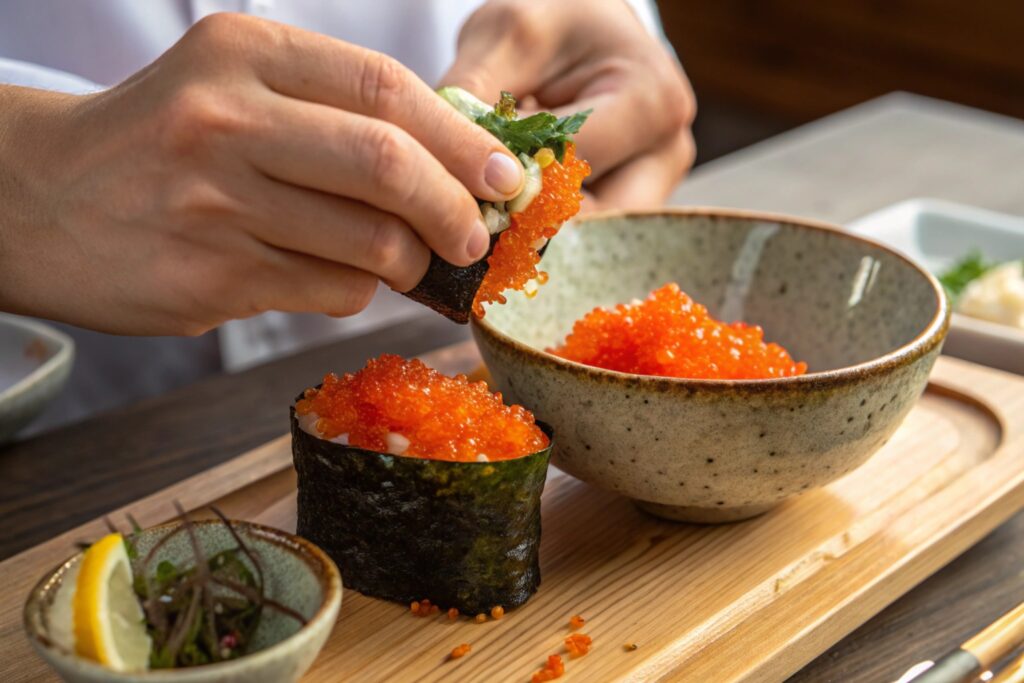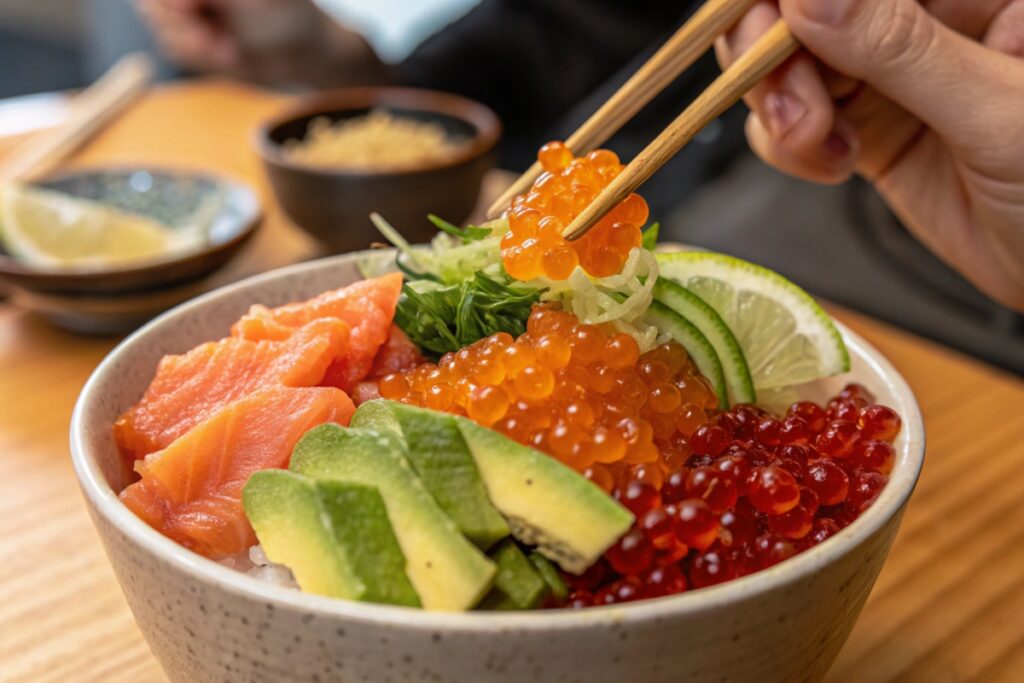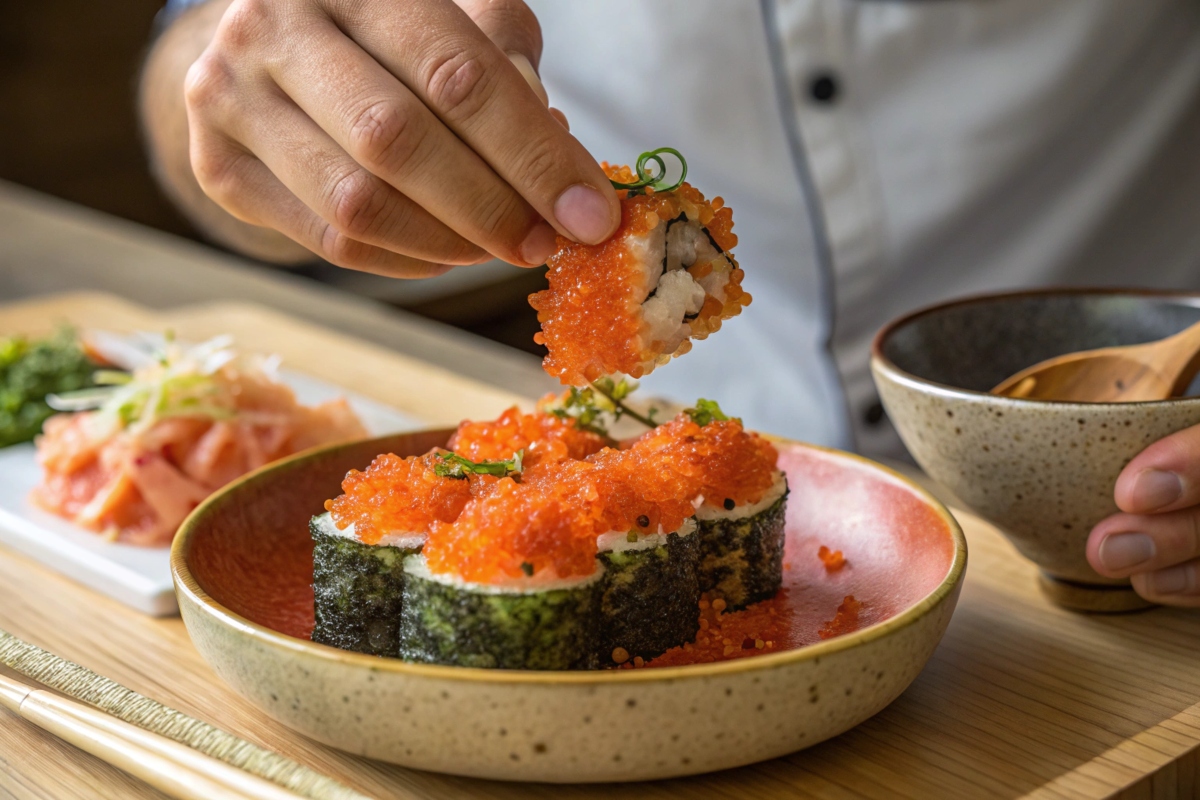Tobiko, the vibrant roe of flying fish, is a beloved ingredient in Japanese cuisine. This article explores its definition, characteristics, types, culinary uses, health benefits, and comparisons with other fish eggs. We’ll also discuss how to store and serve tobiko, along with frequently asked questions to enhance your understanding of this unique delicacy.
1. Introduction to Tobiko
Definition and Origin
Tobiko is the Japanese term for the eggs of the flying fish, known for their small size and distinctive crunch. These tiny, colorful eggs are typically used in sushi and sashimi, adding a burst of flavor and texture to dishes. Originating from Japan, fish eggs has become a staple in various culinary traditions worldwide. The roe is harvested from flying fish, which are primarily found in warm ocean waters. Traditionally, fish eggs is bright orange, but it can also be found in other colors, such as green, black, and red, depending on the flavoring and preparation methods. This versatility makes tobiko a popular choice for chefs and home cooks alike.
Characteristics of Tobiko
Tobiko is characterized by its small, round shape and vibrant colors. Each egg measures about 0.5 to 0.8 millimeters in diameter, making them larger than masago (capelin roe) but smaller than ikura (salmon roe). The texture of tobiko is unique; it has a satisfying pop when bitten into, releasing a burst of flavor. Additionally, fish eggs is often seasoned with various ingredients, such as wasabi or squid ink, to create different flavor profiles. This adaptability allows it to complement a wide range of dishes, from traditional sushi rolls to modern fusion cuisine. Furthermore, the visual appeal of tobiko enhances the presentation of any dish, making it a favorite among chefs.
Nutritional Value of Tobiko
In addition to its culinary appeal, tobiko offers several nutritional benefits. It is a good source of protein, providing essential amino acids that support muscle growth and repair. Moreover, fish eggs is rich in omega-3 fatty acids, which are known for their heart-healthy properties. These healthy fats can help reduce inflammation and lower the risk of heart disease. Additionally, fish eggs contains vitamins and minerals, including vitamin B12, selenium, and iron, which contribute to overall health. However, it’s important to consume fish eggs in moderation, as it can be high in sodium. Overall, incorporating tobiko into your diet can provide a flavorful and nutritious boost to your meals.

2. Types of Tobiko
Traditional Tobiko Varieties
Tobiko comes in several traditional varieties, each with its unique flavor and characteristics. The most common type is the classic orange fish eggs , which has a slightly sweet and briny taste. This variety is often used in sushi rolls and as a garnish for sashimi. Additionally, there are other colors of fish eggs , such as green, which is infused with wasabi for a spicy kick, and black, which is made using squid ink. These variations not only enhance the visual appeal of dishes but also offer different flavor profiles that can elevate your culinary creations. Furthermore, the choice of tobiko can significantly impact the overall taste of a dish, making it essential to select the right type for your recipe.
Flavored Tobiko Options
In recent years, flavored tobiko has gained popularity among chefs and food enthusiasts. These innovative options include fish eggs infused with ingredients like yuzu, a citrus fruit, or spicy chili, adding a zesty twist to the traditional flavor. Flavored fish eggs can be used creatively in various dishes, from sushi to salads, providing an exciting burst of taste. Moreover, these unique varieties allow for greater experimentation in the kitchen, encouraging cooks to think outside the box. When selecting flavored fish eggs , it’s essential to consider how the added flavors will complement the other ingredients in your dish, ensuring a harmonious balance of tastes.
3. Culinary Uses of Tobiko
Tobiko in Sushi and Sashimi
Chefs love using tobiko in sushi and sashimi because it adds both flavor and texture. They often use it as a topping for nigiri, placing a small mound of fish eggs atop a slice of fish or rice. Additionally, you can incorporate fish eggs into maki rolls, providing a delightful crunch with each bite. The vibrant colors of fish eggs enhance the visual appeal of sushi, making it more enticing. Furthermore, the versatility of fish eggs allows you to pair it with various ingredients, from fresh fish to vegetables, creating a well-rounded flavor experience. When preparing sushi, consider using tobiko to elevate your dish and impress your guests.
Creative Dishes Featuring Tobiko
Beyond sushi, you can use fish eggs in a variety of creative dishes. For instance, sprinkle it over salads for added texture and flavor, or mix it into sauces to enhance their taste. You can also incorporate tobiko into pasta dishes, providing a unique seafood twist. Moreover, use it as a garnish for soups and appetizers, adding a pop of color and flavor. The possibilities are endless when it comes to using fish eggs in your cooking. By experimenting with different recipes, you can discover new ways to enjoy this delightful ingredient and impress your friends and family with your culinary skills.
4. Health Benefits of fish eggs
Nutritional Benefits
Tobiko is not just a tasty addition to your meals; it also offers several nutritional benefits. These tiny fish eggs are rich in protein, which is essential for building and repairing tissues in the body. Additionally, fish eggs contains omega-3 fatty acids, known for their heart-healthy properties. These healthy fats can help reduce inflammation and lower the risk of heart disease. Moreover, fish eggs is a good source of vitamins and minerals, including vitamin B12, which supports nerve function and energy production. Incorporating tobiko into your diet can provide a flavorful way to boost your nutrient intake while enjoying its unique taste.
Is Tobiko Healthy?
When considering whether tobiko is a healthy choice, it’s important to look at its nutritional profile. While it is low in calories, it can be high in sodium, especially if consumed in large quantities. Therefore, moderation is key. For most people, enjoying fish eggs as part of a balanced diet can be beneficial. However, those with specific dietary restrictions, such as individuals on low-sodium diets, should be cautious. Additionally, the health benefits of fish eggs can be enhanced when paired with other nutritious ingredients, such as fresh vegetables and whole grains. Overall, tobiko can be a healthy addition to your meals when consumed mindfully.
5. Tobiko vs. Caviar
What Makes Tobiko Different from Caviar?
While both tobiko and caviar represent types of fish roe, they originate from different species and exhibit distinct characteristics. Harvesters collect fish eggs from flying fish, whereas sturgeon provide caviar. This difference in source creates variations in flavor, texture, and price. Generally, fish eggs appears smaller and offers a crunchier texture compared to the larger, creamier eggs of caviar. Moreover, tobiko often comes at a more affordable price, making it a popular choice for those who want to enjoy a gourmet experience without overspending.
Price Comparison
When it comes to price, tobiko usually proves much more budget-friendly than caviar. High-quality caviar can be quite expensive due to the rarity of sturgeon and the labor-intensive harvesting process. In contrast, you can find fish eggs more widely available at various price points, making it accessible for everyday meals. This affordability encourages home cooks to experiment with fish eggs in their dishes without the financial commitment associated with caviar. Consequently, fish eggs serves as an excellent alternative for those who want to enjoy the luxury of fish roe without the hefty price tag.
Taste and Texture Differences
The taste and texture of tobiko and caviar also distinguish them from one another. fish eggs delivers a slightly sweet and briny flavor, accompanied by a satisfying pop when you bite into it. This unique texture adds an exciting element to dishes, especially sushi. On the other hand, caviar tends to offer a richer, more buttery flavor with a smoother texture. These differences influence how each ingredient gets used in cooking. For instance, chefs often use tobiko as a garnish or topping, while they typically serve caviar on its own or with minimal accompaniments. Understanding these distinctions helps you choose the right type of roe for your culinary creations.
6. How to Store and Serve fish eggs
Best Practices for Storage
To maintain the freshness and quality of tobiko, you must store it properly. First, always refrigerate fish eggs. Store it in an airtight container to prevent air exposure, which can spoil the roe. Ideally, consume fish eggs within a few days of opening, but it can last up to a week if you store it correctly. If you have unopened fish eggs, keep it in the refrigerator until the expiration date on the package. For longer storage, consider freezing tobiko, but be aware that this may slightly alter its texture. When you’re ready to use it, simply thaw it in the refrigerator overnight.
Serving Suggestions
When serving tobiko, focus on presentation. Use fish eggs as a garnish for various dishes to add a pop of color and flavor. For instance, place it atop nigiri or roll it into maki for sushi. You can also incorporate fish eggs into salads or use it as a topping for seafood dishes to enhance their visual appeal. Additionally, serve tobiko alongside soy sauce, wasabi, and pickled ginger to create a delightful tasting experience. Experimenting with different serving styles will elevate your dishes and impress your guests.

8. Frequently Asked Questions (FAQs)
Is Tobiko Actually Fish Eggs?
Yes, tobiko is indeed fish eggs, specifically the roe of flying fish. These tiny, colorful eggs are a staple in Japanese cuisine, particularly in sushi and sashimi. They are known for their unique texture and flavor, which adds a delightful crunch to dishes. Moreover, fish eggs is often confused with other types of fish roe, such as caviar or masago, but each has its distinct characteristics and culinary uses. Overall, tobiko is a delicious and versatile ingredient that enhances many seafood dishes.
What Does Tobiko Taste Like?
Tobiko has a slightly sweet and briny flavor, with a satisfying pop when bitten into. This unique taste makes it a versatile ingredient that can enhance various dishes. Additionally, flavored fish eggs options, such as wasabi or yuzu, can add a spicy or citrusy twist, further expanding its flavor profile. Overall, tobiko’s delightful taste and texture make it a favorite among sushi enthusiasts and food lovers alike. Its ability to complement other ingredients makes it a valuable addition to many recipes.
Is Tobiko a Caviar?
While both tobiko and caviar are types of fish roe, they come from different species and have distinct characteristics. fish eggs is harvested from flying fish, while caviar typically comes from sturgeon. This difference in source leads to variations in flavor, texture, and price. fish eggs is generally smaller and has a crunchier texture compared to the larger, creamier eggs of caviar. Consequently, tobiko serves as a more affordable alternative for those looking to enjoy the luxury of fish roe without the hefty price tag.
Is Tobiko Healthy?
Tobiko can be a healthy addition to your diet when consumed in moderation. It is low in calories and rich in protein, making it a nutritious choice. Additionally, fish eggs contains omega-3 fatty acids, which are beneficial for heart health. However, it can be high in sodium, so those on low-sodium diets should be cautious. Overall, incorporating tobiko into a balanced diet can provide flavor and nutrition, enhancing your meals while supporting your health.
Conclusion
In summary, tobiko is a delightful ingredient that adds flavor, texture, and visual appeal to various dishes. Understanding what fish eggs is and how to use it can elevate your culinary creations, whether in sushi, salads, or other seafood dishes. Its unique taste and nutritional benefits make it a popular choice among food enthusiasts. For more detailed information about fish eggs, you can visit the Wikipedia page. Additionally, if you’re looking for more recipes and ideas, check out Healthi Recipes for inspiration. Embracing tobiko in your cooking can lead to exciting new flavors and experiences, making it a worthy addition to your kitchen repertoire.

